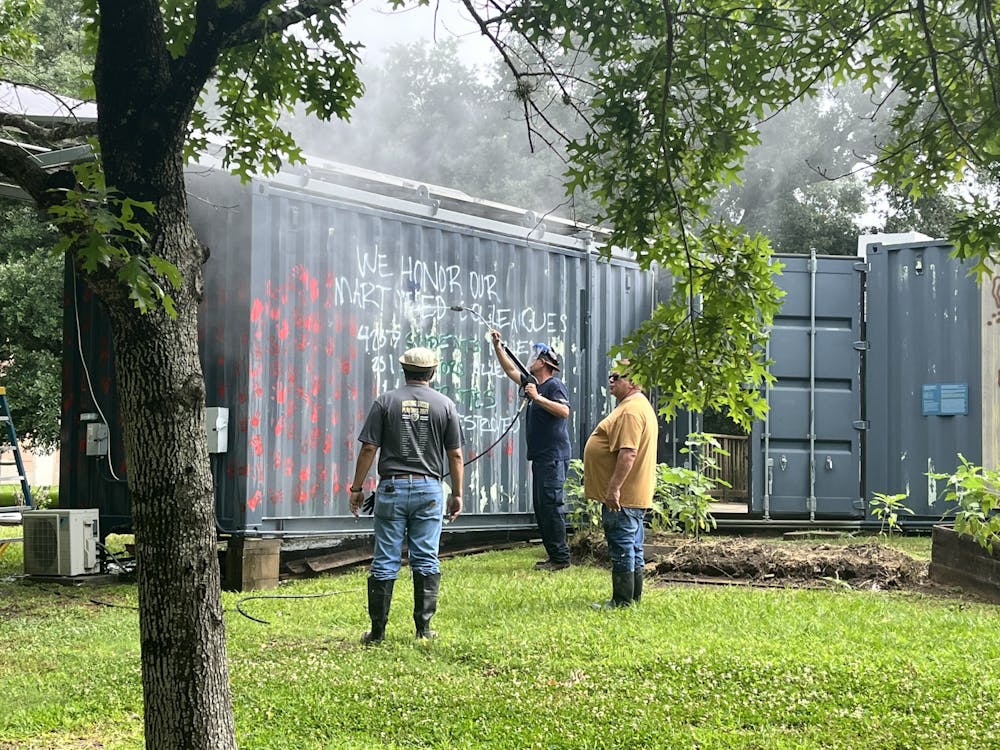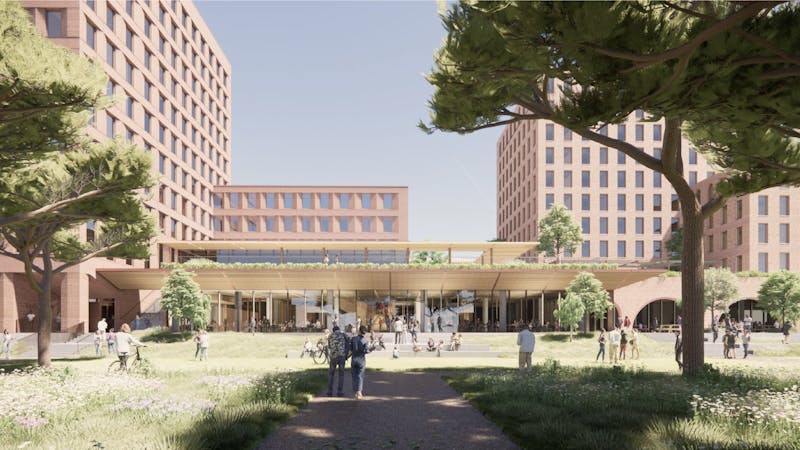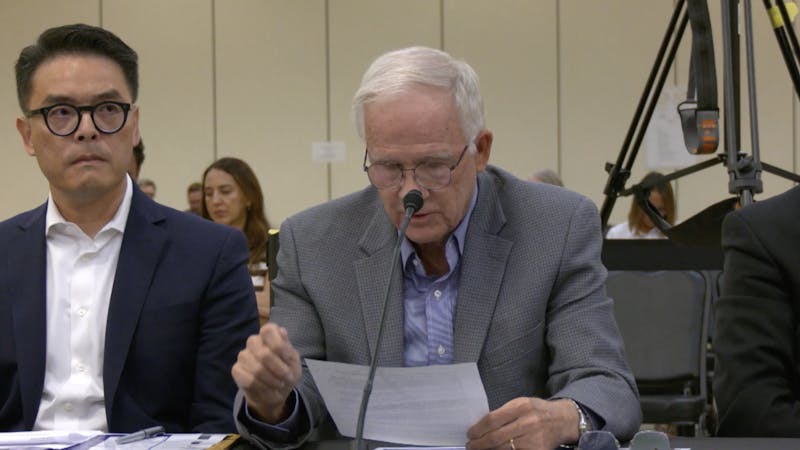Rice SJP ‘liberated zone’ ends, university removes artwork in ‘beautification efforts’

When Rice SJP ended its physical presence at the “liberated zone,” organizers believed the tents and artwork could remain as a “permanent reminder” of SJP’s presence on campus. However, university representatives power washed the graffiti artwork three days after the zone ended. Riya Misra / Thresher
The “liberated zone” on Rice campus and associated events ended Friday, April 26, after four days of programming, according to the Rice Students for Justice in Palestine Instagram page.
Unlike overnight encampments spreading at college campuses across the country, Rice SJP disassembled the “liberated zone” each night and returned the following morning. And in contrast to clashes and escalating police responses that have led to some 2,000 arrests from Los Angeles to Hanover, N.H., there were “no major incidents and no arrests” at Rice, according to President Reggie DesRoches.
At the “liberated zone,” Rice SJP organized events such as teach-ins, art creation and study sessions, according to the Rice SJP Instagram page. The group also hosted guest speakers, including a Palestinian doctor who recently returned from treating patients in Gaza. A few dozen Rice students and community members attended the events each day.
“The students’ activities were met with attention and debate, and not all were in agreement,” DesRoches wrote in an end-of-semester email sent to campus April 28. “But I believe many would concur that the right to responsible, personal expression and protest must be maintained, particularly on a university campus.”
DesRoches also wrote that Rice SJP “made several modifications to help maintain an environment that minimized disruption, departing the space each evening.”
University pressure washes “liberated zone” artwork
When Rice SJP ended its physical presence at the “liberated zone,” located at the Solar Studios exhibit next to the PCF tents, organizer Erica Augenstein said she believed the tents and artwork, consisting of a mural and graffitied shipping container, could remain as a “permanent reminder” of SJP’s presence on campus. However, university representatives pressure washed the graffiti artwork, including phrases such as “we will reclaim Rice for Palestine” and “long live the resistance,” from the shipping container April 29.
“We feel that we negotiated with administrators. We did not stay overnight. We ended the ‘liberated zone,’ like our physical presence here,” Augenstein, a doctoral student in history, said. “We feel like this [mural] represents our continued presence, our continued struggle and we are willing to advocate for its public display in a public location, particularly through graduation, so that it's not something that’s silenced for the optics of campus.”
Chris Stipes, the executive director of news and media relations, confirmed the artwork, which Rice considered a temporary display, was removed.
“As should typically occur with any temporary art installation on Rice’s property, Rice returned the studio space to its previous condition after the event finished,” Stipes wrote in an email to the Thresher.
DesRoches also cited upcoming commencement ceremonies as a cause for “beautification efforts across campus” in his email.
Augenstein said the Houston Climate Justice Museum, which had a temporary exhibition on campus, originally allowed Rice SJP to paint on the side of a shipping container within the exhibit.
“We made an initial agreement with the museum that we would be able to paint the containers, so we painted it on that basis,” Augustine said. “The university has since said that they are taking back control of this entire space, including the containers, and that [they] have beautified it for graduation.”
Stipes said Rice was aware that “some teach-in organizers believed that HCJM had authorized them to use the space.”
“The Houston Climate Justice Museum does not control access to Rice’s property or premises,” Stipes wrote. “Rice then worked with the organizers to clarify their responsibilities and review their request for approval to hold the event.”
Aaron Ambroso, the co-director of the HCJM, said the museum had been working on an installation featuring the work of two Palestinian art groups. When Rice SJP approached them about hosting their “liberated zone” there, he thought their work was “greater” than what the museum had planned.
Ambroso said that while the HCJM is not ending their involvement with the university, their work with the containers is on hold..
“We were in the middle of working on an exhibit [and] the encampment happened,” Ambroso said. “And after the encampment, the studios have been repainted, the mural moved … our work [is] sort of on hold.”
Kathryn Jarjoura, a Rice SJP organizer, said she was bothered by how the Rice administration and RUPD “make up rules on the fly” to “crush” student activism on campus.
“For example, this space was contracted by the climate justice museum,” Jarjoura, a Baker College senior, said. “They were under the impression that they had the space until the summer but then suddenly, it's cut prematurely … [Rice says] it's for beautifying the campus. However, there's graffiti everywhere … They're not fooling anyone; we know that they don't want to be called out on being silent about every university in Gaza being destroyed.”
Mural wall “disassembled,” Rice SJP alleges deliberate destruction
Matti Haacke, another Rice SJP organizer, said that SJP was notified that the mural wall had fallen on April 28. Based on how the mural had split cleanly in half and the redistribution of the sandbags, Haacke alleged intentional destruction of the mural.
“On the FIRST freestanding night of the student-made ‘Popular University for Gaza’ mural, two Zionists were seen deliberately and violently tearing down our mural — which we designed, painted and constructed a wooden frame for over the course of several days,” Rice SJP wrote in an April 30 Instagram post. The Thresher could not independently confirm this account.
Rice University Police Department chief Clemente Rodriguez wrote in an email to the Thresher that RUPD received a report the mural was “disassembled.” Rodriguez did not respond to the claim that the mural was “deliberately and violently” taken down in time for publication.
“The mural was not damaged, and students were able to reassemble and place it back upright,” Rodriguez wrote.
The mural has since been moved to the gravel path outside the Multicultural Center.
“The students received advanced notice [the mural would be moved] and they worked with Rice officials to find a place to preserve the mural,” Stipes wrote. “The tents and banner, which were not destroyed, were also moved to the MCC.”
Four days in the zone
Haacke said the “liberated zone” served as a “powerful community-building space” as they saw numerous new individuals attend events over the four days.
“In collective solidarity with Gaza, we had a lot of powerful education, teaching about history, teaching about current movements, teaching about struggle and solidarity struggles, bringing art into this space,” Haacke said. “It was an experience that really established hope for a future where we can have these communal spaces that aren't facilitated on campuses and be able to really critically engage with issues we're seeing.”
Augenstein said she believes the events were successful, given the short period of time Rice SJP had to organize and the Rice campus’ lower interest in activism.
“Given that Rice University, generally speaking, doesn't have the same density of student activism as other campuses around the country, we can't really defend a true encampment or an occupation of the main quad, for example,” Augenstein said.
Haacke said one of the most impactful speakers was the orthopedic surgeon who had returned from Gaza last week and shared his experience providing medical care in a war zone.
“[His] highest priority [is getting someone on their feet] because you really never know when the next bomb is going to drop,” Haacke said. “He also talked about … the power of student activism, not only in disrupting the systems in America, but giving people hope. He talked about how, even showing pictures of our liberated zone and the student activism around the country is … giving people in a war zone hope to live.”
Student protests across the nation
The “liberated zone” at Rice was one of numerous encampments and protests at university campuses across the country.
Some zones have remained peaceful, such as Rice’s and those at Northwestern University, which ended April 29 after university administrators and organizers brokered a deal.
But encampments at dozens of other universities have led to mass arrests. The New York Police Department first swept an encampment at Columbia University on April 18, arresting more than 100 demonstrators. In the two weeks since, universities across the country have asked law enforcement to clear encampments and, in some cases, occupied buildings, as more than 2,000 people have been arrested or detained. Many encampments are ongoing.
Two Texas campuses have seen the Texas Department of Public Safety intervene with state troopers.
At the University of Texas at Austin, upon request from university president Jay Hartzell, police officers dressed in riot gear and armed with stun grenades and pepper spray made over 100 arrests on April 29. Hartzell’s response drew mixed praise from political colleagues and condemnation from 165 faculty members, who signed an open letter criticizing the “heavy police intervention.”
State troopers also swept an encampment at the University of Texas at Dallas on May 1, making 21 arrests.
Texas Governor Greg Abbott posted on X, formerly known as Twitter, “No encampments will be allowed. Instead, arrests are being made,” on April 30 in response to a video of law enforcement at UT Austin.
More from The Rice Thresher

Rice announces Chao College as 12th residential college
Rice announced that the 12th residential college will be named Ting Tsung and Wei Fong Chao College Aug. 19. The college, set to open in fall 2026, will contain nearly 300 on-campus beds.
Dining access fund announced following on-campus unlimited meal swipes
Rice announced new food assistance programs on Tuesday to account for the controversial change in the on-campus meal swipe plan.

Rice disaster prediction model discussed at hearing on deadly Central Texas floods
The House and Senate Select Committees on Disaster Preparedness and Flooding held a hearing on July 31 in Kerrville to address the deadly July 4 flooding in Central Texas. The flooding along the banks of the Guadalupe River killed 108 people, including 37 children. In the charged hearing, Texas lawmakers and flood survivors criticized the local response to the disaster.


Please note All comments are eligible for publication by The Rice Thresher.